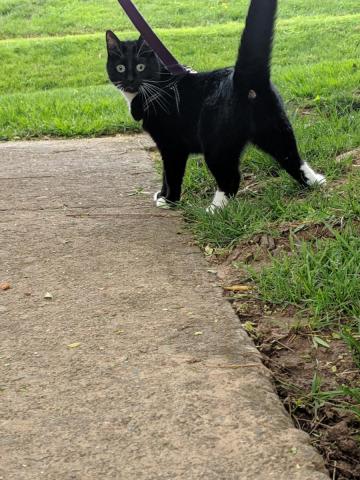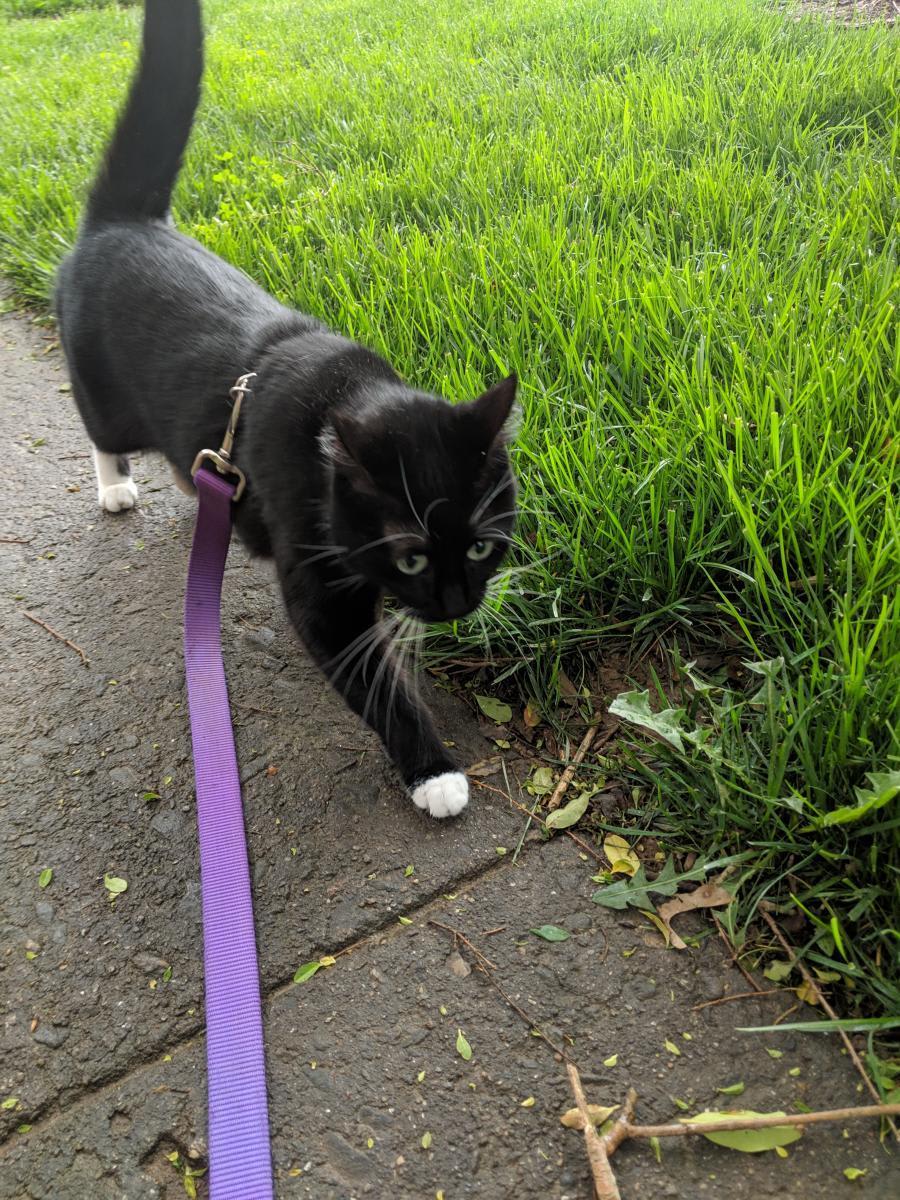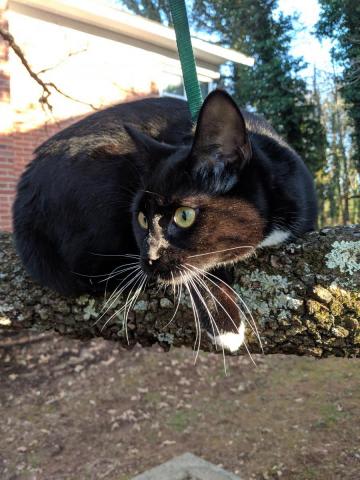
Some cats can become great adventurers where they get the benefit of exploring outside with the safety of being on a leash. It may not be the right enrichment for all cats, but here on some tips on where to begin leash training.
By: Anastasia Galbo
Poe and Lucifer, our brother and sister duo love long walks in the forest, sunny spots to lie in, and a good tree to climb.
Poe (4 years) and Lucifer (10 months) both love being outside more than anything. Living in a busy city like Asheville makes it too dangerous to let them roam free on their own. So we introduced them to a harness and the local park.
Poe took to it naturally; she even now pulls her harness from the basket when she wants to go out. She was 4 years old when we introduced the idea of a harness to her. To her, it seemed to be the answer she’d been looking for. The first time we took her outside she was a little skeptical and wary of her new surroundings. She kept herself low to the ground and kind of slinked around for a good 10 minutes. Once we were further from the sounds of traffic, though, she came out of her shell. She started eating grass, climbing trees, and chasing bugs. She was incredibly happy!
On the other hand, Lucifer, our youngest, was very unsure of it during his first few trips. He’d rather hide in the bushes and take in the sights, rather than explore like his sister. We thought he would be much more adaptable to the harness and excited to go outside from the start like his sister. He would much rather be carried around in my arms than walk around himself. After several outings, he warmed up to the idea of walking around. While still staying close to me, he did rather like hiding in the grass and sitting in trees. The reason we continue to take him out was because he continues to ask to go outside. He enjoys being outside with his human.
Your Cat(s) and Adventuring
As you can see, different cats have different reactions to being walked around. While neither of my cats fought the harness, Lucifer didn’t like the idea of the leash as much as Poe. Surprisingly, even with Lucifer being so young (he started training when he was 10 weeks old), he still isn’t fully into the idea of being a high exploring adventure cat. He prefers quieter adventures.
Poe, alternatively, even at 4 years old, took to it immediately and now demands to be walked at least once a day with the dogs.
To prepare your fur-baby for an adventure, the first thing is to take a trip to the vet. You want to make sure your cat has all his or her vaccines and is healthy. You will want to make sure your feline friend is up to date on the recommended parasite prevention as well.


After that, it’s time to accessorize! Finding the right harness for your cat can be difficult, as there are so many types. Poe used just a lightweight T shaped harness. These are nice because the lesser fabric can be helpful for getting your cat used to wearing a harness. Lucifer wears a mesh full harness, because he is slinky, and can get out of a T harness. My personal favorite is the mesh harness because it’s harder to escape from. Since cats have floating collar bones, they can squeeze in or out of pretty much anything, so you need to make sure the harness fits well but not too tightly.
Start with placing the harness on your cat indoors and for short periods of time. Make it fun and use rewards such as treats, petting, or playtime to help associate the harness with fun times. Do not drag your cat. Let them explore while on the leash. Click Here for a great article on how to train your cat to walk on a leash.
Start teaching your cat their name and to come when called with positive reinforcement techniques. Coming when called can help get your cat’s attention and out of a potentially dangerous situation.
After you have introduced your cat to the idea of a harness, and they haven’t objected to it, it’s time to take them out. You want to take them either in your yard, ideally away from road noise, or to a park with little traffic and no dogs. Even if your cat is used to dogs, it’s usually better to keep it low key. This is already a stressful thing, being away from their normal territory, so we don’t want to add any extra stress.
Train your cat to ride in a carrier or backpack that you can take on the adventure. A carrier or backpack can be not only their safe spot if they should get scared or tired but also a safe space during travel.
Training your cat to ride in the car is essential to get to some of your adventures. Making their carrier a comfortable and exciting place will help keep them safe in the car.
Be Prepared: Have a first aid bag on hand. This bag should include a first aid kit for cats, a book about feline first aid (The American Red Cross has a Cat First Aid Book), and a waterproof bag or laminated phone list with your veterinarian’s phone number, the local 24 hours emergency veterinary clinic, and the ASPCA Poison Control phone number (888-426-4435) and your cat’s medical and vaccine records with a current photo of your cat.
And do not forget clean water and food/treats for your cat, especially for longer adventures.
With practice and patience, your cats can become great adventurers. This can also be a great bonding experience with your fur-baby. But remember, not all cats are up to it. Follow your cat’s lead; if they seem too stressed out, take it slower or back off the idea. We want this to be an enjoyable and enriching experience for you both.
Have fun exploring, and be safe!

